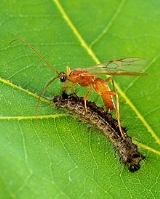
Wasp
Overview
The term wasp is typically defined as any insect
of the order Hymenoptera
and suborder Apocrita
that is neither a bee
nor an ant
. Almost every pest insect species has at least one wasp species that preys upon it or parasitizes
it, making wasps critically important in natural control of their numbers, or natural biocontrol
. Parasitic wasp
s are increasingly used in agricultural pest control
as they prey mostly on pest insects and have little impact on crops.
The majority of wasp species (well over 100,000 species) are "parasitic" (technically known as parasitoid
s), and the ovipositor
is used simply to lay eggs, often directly into the body of the host.
Insect
Insects are a class of living creatures within the arthropods that have a chitinous exoskeleton, a three-part body , three pairs of jointed legs, compound eyes, and two antennae...
of the order Hymenoptera
Hymenoptera
Hymenoptera is one of the largest orders of insects, comprising the sawflies, wasps, bees and ants. There are over 130,000 recognized species, with many more remaining to be described. The name refers to the heavy wings of the insects, and is derived from the Ancient Greek ὑμήν : membrane and...
and suborder Apocrita
Apocrita
Apocrita is a suborder of insects in the order Hymenoptera.Apocrita includes wasps, bees and ants, and consists of many families. It includes the most advanced hymenopterans and is distinguished from Symphyta by the narrow "waist" formed between the first two segments of the actual abdomen; the...
that is neither a bee
Bee
Bees are flying insects closely related to wasps and ants, and are known for their role in pollination and for producing honey and beeswax. Bees are a monophyletic lineage within the superfamily Apoidea, presently classified by the unranked taxon name Anthophila...
nor an ant
Ant
Ants are social insects of the family Formicidae and, along with the related wasps and bees, belong to the order Hymenoptera. Ants evolved from wasp-like ancestors in the mid-Cretaceous period between 110 and 130 million years ago and diversified after the rise of flowering plants. More than...
. Almost every pest insect species has at least one wasp species that preys upon it or parasitizes
Parasitism
Parasitism is a type of symbiotic relationship between organisms of different species where one organism, the parasite, benefits at the expense of the other, the host. Traditionally parasite referred to organisms with lifestages that needed more than one host . These are now called macroparasites...
it, making wasps critically important in natural control of their numbers, or natural biocontrol
BioControl
BioControl is a peer-reviewed scientific journal published by Springer Science+Business Media covering all aspects of basic and applied research in biological control of invertebrate, vertebrate, and weed pests, and plant diseases. The journal was established in 1956 as Entomophaga and published by...
. Parasitic wasp
Parasitic wasp
The term parasitoid wasp refers to a large evolutionary grade of hymenopteran superfamilies, mainly in the Apocrita. They are primarily parasitoids of other animals, mostly other arthropods...
s are increasingly used in agricultural pest control
Pest control
Pest control refers to the regulation or management of a species defined as a pest, usually because it is perceived to be detrimental to a person's health, the ecology or the economy.-History:...
as they prey mostly on pest insects and have little impact on crops.
The majority of wasp species (well over 100,000 species) are "parasitic" (technically known as parasitoid
Parasitoid
A parasitoid is an organism that spends a significant portion of its life history attached to or within a single host organism in a relationship that is in essence parasitic; unlike a true parasite, however, it ultimately sterilises or kills, and sometimes consumes, the host...
s), and the ovipositor
Ovipositor
The ovipositor is an organ used by some animals for oviposition, i.e., the laying of eggs. It consists of a maximum of three pairs of appendages formed to transmit the egg, to prepare a place for it, and to place it properly...
is used simply to lay eggs, often directly into the body of the host.
Discussions

